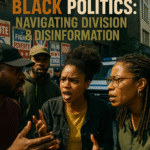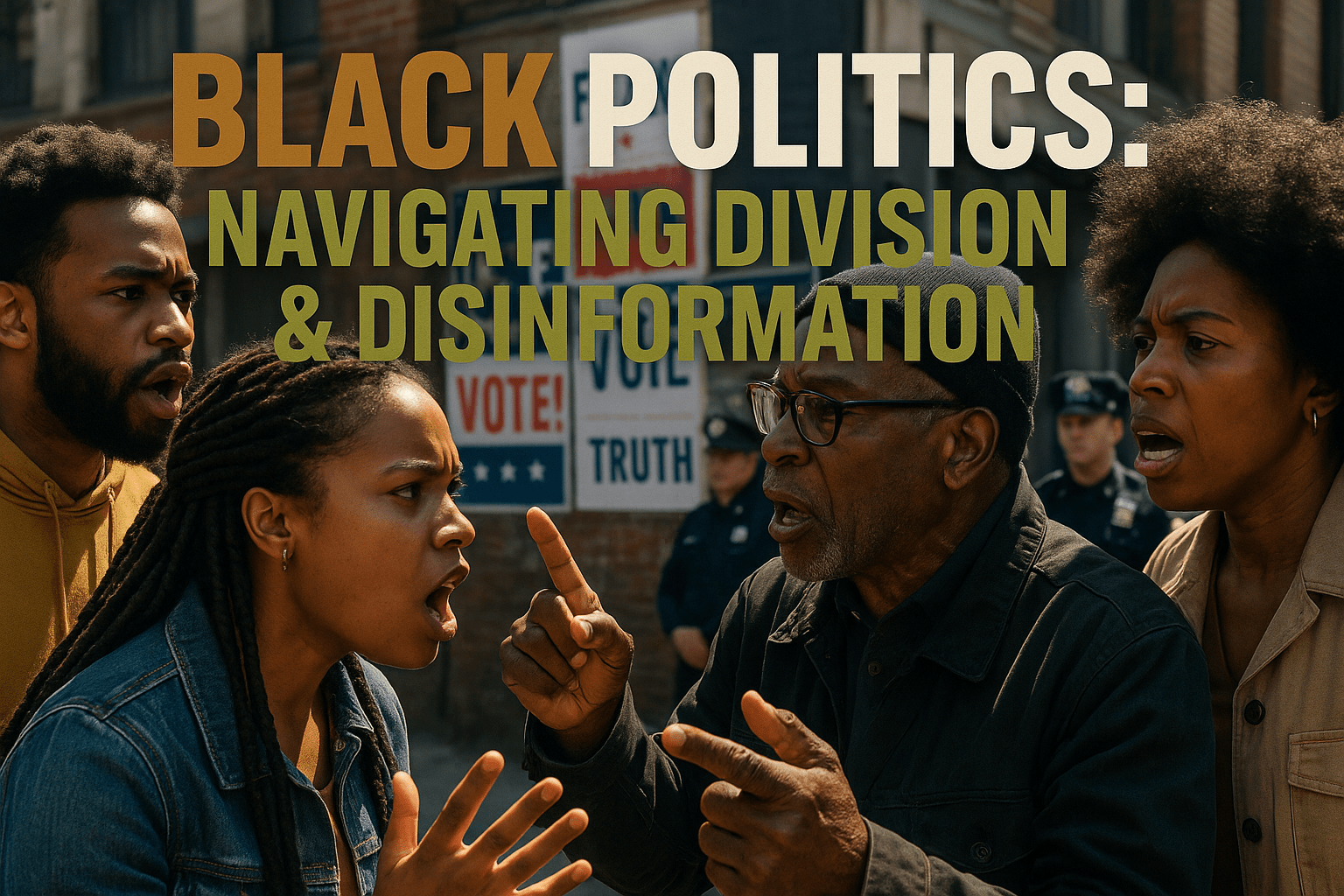

Black Politics: Navigating Division & Disinformation
By Darius Spearman (africanelements)
Support African Elements at patreon.com/africanelements and hear recent news in a single playlist. Additionally, you can gain early access to ad-free video content.
The Political Landscape for Black Americans
Elections carry significant consequences. This truth becomes especially clear when comparing the actions of victorious politicians with the promises of those who lost. In Washington, D.C., particularly in the Southeast, Black residents are experiencing heightened scrutiny. People face harassment for activities like smoking marijuana on their stoops, which is legal in D.C., but can lead to losing Section 8 housing due to federal authority. Furthermore, simply recording the visible presence of law enforcement, including the National Guard, FBI, DEA, and D.C. police, marching through the streets has become a point of contention. Black neighborhoods are under a kind of siege, a situation that even former New York City mayor Rudy Giuliani, known for his “stop and frisk” and “broken window” policing strategies, might find impressive.
In America, political ideologies span a wide spectrum. While communism on the left has few adherents in 2025, fascism on the right finds enthusiasts within the current Trump administration. Most Americans, however, prefer politicians closer to the political center. Discussions often revolve around how much money to spend, or not spend, on the priorities of the party in power. However, the 2024 presidential election was not about centrist policies. Instead, it presented an existential threat to Black people. The choice was stark: a conventional political candidate in Kamala Harris for the Democratic Party, or Donald Trump, a criminal felon found liable for sexual assault, representing the GOP.
Divisive Movements in the Black Community
For many rational individuals, even if they disagreed with Harris’s policies or knew little about them, the presidential choice should have been straightforward. It came down to trusting either a Black woman with a distinctive laugh or a white man with numerous criminal indictments and problematic associations. This was, for many, a difficult decision. The majority of Black people, despite some shifts among Black male voters drawn to notions of misogyny, proximity to power, or transactional philosophies, recognized the threat and voted accordingly. However, a vocal minority of Black individuals used social media to discourage voting or to advocate for voting for anyone but the top of the ballot. They argued that if both the Republican and Democratic parties were equally flawed, then the occupant of the White House did not matter.
These individuals often identified with the FBA (Foundational Black Americans) and ADOS (American Descendants of Slavery) movements. While these are technically distinct groups with different leaders, their shared ideology promotes xenophobia and a fetishization of ancestry and lineage. They create division within the Black community by emphasizing whether one’s ancestry is tied to slavery. This approach, some argue, serves as a “white supremacist dream.” It is almost as if former FBI chief J. Edgar Hoover had resurrected, sending a COINTELPRO 2.0 battle plan to impressionable Black individuals, unleashing a wave of flag-bearing, hashtag-loving, xenophobic Black social media accounts upon the Black community, and then observing the resulting chaos.
Understanding Divisive Ideologies
FBA (Foundational Black Americans) and ADOS (American Descendants of Slavery) movements are criticized for promoting xenophobia, fetishizing ancestry, and creating division within the Black community (levelman.com). Critics argue that their rhetoric often stereotypes African and West Indian immigrants and includes baseless attacks on Pan-Africanism. Some adherents are accused of believing that Black immigrants “leech” benefits from African Americans, despite the significant issues African Americans face, such as police brutality and environmental injustice (levelman.com).
The Impact of Misinformation
The spread of information, particularly within the Black community, holds immense value. Black people have historically needed to create independent forms of information, from Black newspapers to Black Twitter, to tell their stories authentically. There is an inherent trust that those disseminating information are working in the community's best interest. However, this trust is not always warranted, especially concerning the FBA and ADOS movements.
Before the election, these groups actively spread misinformation about candidate Harris. In a thinly veiled attempt to echo the Trump administration's talking points, they questioned whether Harris was truly a Black woman, a tactic also employed by Trump at the National Association of Black Journalists. They disparaged her as a “cop,” ignoring the crucial role both criminal defense attorneys and criminal prosecutors play in the judicial system for Black people. Most egregiously, as a subtle voter suppression tactic, they urged Black people not to vote. They claimed to see no difference between a Democratic candidate and a “white supremacist, white nationalist, fascist criminal president.”
Consequences of Political Choices
Now, as military forces move through D.C. and Republican politicians openly discuss bringing similar situations to other Black cities and neighborhoods, these “chaos agents” have suddenly realized the consequences. When a Black community faces martial law, the state does not differentiate between those whose ancestors arrived on the Mayflower and those who recently immigrated from Kingston. They are now scrambling to create social media discussions, expressing shock that the “white supremacist” they claimed was no different from the “lovely Black lady” who offered housing credits and civil rights protections is, in fact, acting out the “crazy white supremacist things” he promised.
They are discovering that adopting a nativist nationalist ideology of “blood and soil” does not include them in either the “blood” or the “soil.” The “monster” does not care about their xenophobia or “diaspora wars.” He will still attempt to strip their history from institutions like the National African American History Museum. As Malcolm X famously stated, “They don’t hang you because you’re from America, Canada, Ghana, or Trinidad; they hang you because you’re Black.”
The Trump Factor and White Supremacy
Donald Trump's actions and rhetoric have been analyzed for their alignment with “White Narcissistic Racist” traits and their impact on white supremacist movements and the Republican Party. Research examines whether Trump exemplifies traits outlined by Dr. Amos Wilson in “Black on Black Violence: The Psychodynamics of Black Self-Annihilation in Service of White Domination” (papers.ssrn.com). Psychological analyses, firsthand accounts, and Trump's own statements are used to determine the extent to which his behaviors align with Wilson's profile (papers.ssrn.com). Primary sources such as “Too Much and Never Enough” by Mary Trump, “Tower of Lies” by Barbara A. Res, and “Fire and Fury” by Michael Wolff are cited to validate these traits (papers.ssrn.com).
The impact of Trump's traits post-January 6th on white supremacist movements and the Republican Party is analyzed using sources such as “Sedition Hunters,” “Blowback,” and “The January 6 Report” (papers.ssrn.com). His impact on electoral politics and the mobilization of white nationalism is a key area of examination (tandfonline.com). Trump's three-fold strategy of “divide, divert, and conquer” was crucial to his communications campaign and is understood within the longstanding context of immigration and white supremacy in the U.S. (mdpi.com). Racist nativism, or framing descendants from certain nations as incapable of being American, is key to comprehending the internal divisiveness in Trump's strategy (mdpi.com).
Mobilization
Conquer” Strategy
Challenging Historical Narratives
There are alternative perspectives that challenge conventional narratives about the origins of Black people in the Americas, suggesting a deeper indigenous connection. One counter-narrative proposes that North and South America were originally the native lands of peoples now labeled “Americas Blacks,” challenging the traditional European conquest narrative (medium.com). This perspective draws on declassified documents and re-examines historical texts, including those from the Smithsonian Institute and works by Michelle Alexander, to support its claims (medium.com).
This counter-narrative offers a different lens through which to view the history of Black people in the Americas, moving beyond the sole focus on the transatlantic slave trade. It suggests that some Black populations may have indigenous roots in the Americas that predate European colonization. This perspective encourages a re-evaluation of historical records and a deeper exploration of the complex origins of Black identity in the Western Hemisphere.
Racial Bias in Sports and Beyond
Allegations of racial bias continue to surface in various sectors, including professional sports. Shedeur Sanders has initiated a $100 million NFL lawsuit concerning alleged racial bias (allhiphop.com). This lawsuit highlights ongoing concerns about how Black athletes are perceived and treated within professional sports organizations (allhiphop.com). Such cases underscore the pervasive nature of racial bias, extending even into highly visible and celebrated fields like professional athletics.
The Sanders lawsuit is a reminder that despite advancements, systemic issues of racial bias persist. It brings to light the challenges Black individuals face in various professional environments, where their talent and contributions may be undermined by prejudice. These legal battles are crucial for addressing inequities and advocating for fair treatment for all, regardless of race.
Key Allegations of Racial Bias
- Shedeur Sanders' $100 million NFL lawsuit over alleged racial bias highlights concerns about the treatment of Black athletes in professional sports.
- The FBA/ADOS movements are criticized for promoting xenophobia and creating division within the Black community, aligning with white supremacist goals.
- Donald Trump's rhetoric and actions are analyzed for their alignment with “White Narcissistic Racist” traits and their impact on white supremacist movements.
The Path Forward for Black Unity
For FBA/ADOS adherents, it may be too late. They can continue to operate under the banner of lineage, display American flags on their profiles, and believe that their tactics of Black division will somehow result in reparations for Black Americans. However, most Black people now recognize them as discredited. Someone once described Newt Gingrich as a “dumb person’s idea of a smart person,” and the same can be said of FBA and ADOS: they represent a “dumb Black person’s idea of a smart Black movement.” Yet, the blame does not lie with those who are simply seeking a philosophy to guide their lives. Everyone searches for a framework, whether religious or social justice-oriented, trusting that the movement's inherent premise is to move the individual or community in a positive, forward direction.
To combat the assault on Washington, D.C.'s Black community and other Black communities to come, whether as a provocation to justify incarcerating more Black people through increased police contact or as a means of voter suppression during midterms with the military acting as an intimidation force, FBA and ADOS cannot be trusted as movements. They became philosophically bankrupt when they failed to see, identify, or strategize against a threat that was obvious to the majority of intelligent Black voters. Ultimately, Donald Trump's actions are his responsibility. He is the arsonist carrying the gasoline in Washington, D.C., and he is responsible for the fire he creates. However, FBA/ADOS adherents were determined to tell Black people living in D.C. and throughout the country that the firefighter and the arsonist were the same. For that reason alone, their words should no longer be heeded. Elections, after all, have consequences.
ABOUT THE AUTHOR
Darius Spearman has been a professor of Black Studies at San Diego City College since 2007. He is the author of several books, including Between The Color Lines: A History of African Americans on the California Frontier Through 1890. You can visit Darius online at africanelements.org.
